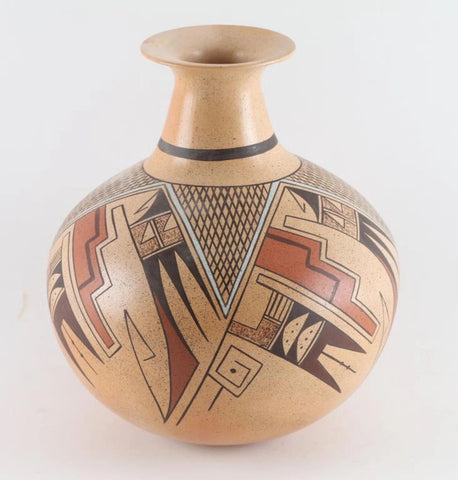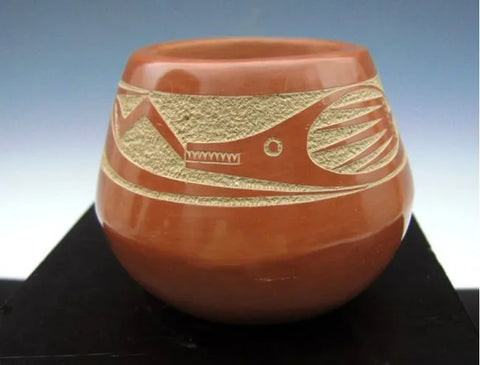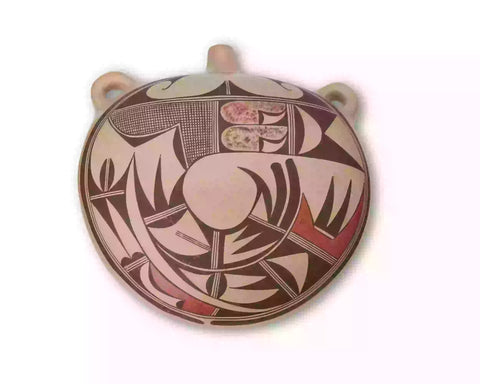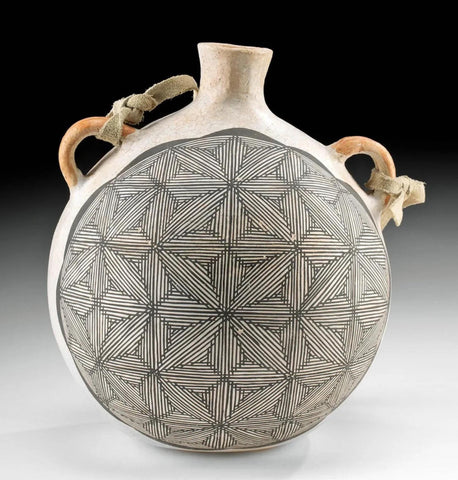
Native American Acoma Poly Chrome Pottery Jar, by Delores Aragon, #1173
$ 5,500.00
Native American
Acoma Poly Chrome Pottery Jar, by Delores Aragon, #1173
Description: #1173 Native American Acoma Poly Chrome Pottery Jar, by Delores Aragon. 2010 poly chrome painted design pottery jar signed Delores Aragon has 2nd place SWAIA ribbon.
Delores had the following to say about this piece " This is a pre-20th century water jar. I can only imagine what the lady who made & painted this original piece I replicated, was praying for. Acoma relies on water & rain for so much, so certain prayers go into the entire process from getting the clay from Mother Earth to producing a piece that has its own life & shape it wants to take. The 4 sides represent the directions. Black represents the clouds. Lines are Rain which produce growth of life, plants, mankind & such. The flowers are Blessings of all the good things in life, prayers answered".
Dimensions: 5'' x 6''
Condition: Excellent
Dolores (D.J.) Aragon (1969- ) Delores M. Aragon is named after her grandmother, Delores Sanchez a respected potter who lived to the age of 103. The younger Delores began making clay animal figures at the age of five. She learned by watching her grandmother and mother, Marie S. Junanico. Her mother-in-law, Wanda Aragon, also reinforced traditional techniques in Acoma pottery making.
Today, Delores is especially known for her fine miniatures. The artist recognized her ancestors, "The old techniques of my ancestors have motivated me even more so to become a part of this tradition. By doing so, I too try different techniques. My grandmother and those before her were strong in keeping the spirit and tradition alive."
Delores believes strongly that you must feel the spirit of pottery deep in your heart. She shared the spiritual dimension of pottery: "They can be really sacred, if you believe in it. It makes me feel good - a part of our ancestors - to do it in the traditional way." (Brown 1993:19) (Source: Adobe Gallery)
A History of Pueblo Pottery:
“Pueblo pottery is made using a coiled technique that came into northern Arizona and New Mexico from the south, some 1500 years ago. In the four-corners region of the US, nineteen pueblos and villages have historically produced pottery. Although each of these pueblos use similar traditional methods of coiling, shaping, finishing and firing, the pottery from each is distinctive.
Various clay's gathered from each pueblo’s local sources produce pottery colors that range from buff to earthy yellows, oranges, and reds, as well as black. Fired pots are sometimes left plain and other times decorated—most frequently with paint and occasionally with appliqué. Painted designs vary from pueblo to pueblo, yet share an ancient iconography based on abstract representations of clouds, rain, feathers, birds, plants, animals and other natural world features.
Tempering materials and paints, also from natural sources, contribute further to the distinctiveness of each pueblo’s pottery. Some paints are derived from plants, others from minerals. Before firing, potters in some pueblos apply a light colored slip to their pottery, which creates a bright background for painted designs or simply a lighter color plain ware vessel. Designs are painted on before firing, traditionally with a brush fashioned from yucca fiber.
Different combinations of paint color, clay color, and slips are characteristic of different pueblos. Among them are black on cream, black on buff, black on red, dark brown and dark red on white (as found in Zuni pottery), matte red on red, and polychrome—a number of natural colors on one vessel (most typically associated with Hopi). Pueblo potters also produce undecorated polished black ware, black on black ware, and carved red and carved black wares.
Making pueblo pottery is a time-consuming effort that includes gathering and preparing the clay, building and shaping the coiled pot, gathering plants to make the colored dyes, constructing yucca brushes, and, often, making a clay slip. While some Pueblo artists fire in kilns, most still fire in the traditional way in an outside fire pit, covering their vessels with large potsherds and dried sheep dung. Pottery is left to bake for many hours, producing a high-fired result.
Today, Pueblo potters continue to honor this centuries-old tradition of hand-coiled pottery production, yet value the need for contemporary artistic expression as well. They continue to improve their style, methods and designs, often combining traditional and contemporary techniques to create striking new works of art.” (Source: Museum of Northern Arizona)
----------
View the other items in my shop: http://www.etsy.com/shop/CulturalPatina?ref=shopsection_shophome_leftnav
Acoma Poly Chrome Pottery Jar, by Delores Aragon, #1173
Description: #1173 Native American Acoma Poly Chrome Pottery Jar, by Delores Aragon. 2010 poly chrome painted design pottery jar signed Delores Aragon has 2nd place SWAIA ribbon.
Delores had the following to say about this piece " This is a pre-20th century water jar. I can only imagine what the lady who made & painted this original piece I replicated, was praying for. Acoma relies on water & rain for so much, so certain prayers go into the entire process from getting the clay from Mother Earth to producing a piece that has its own life & shape it wants to take. The 4 sides represent the directions. Black represents the clouds. Lines are Rain which produce growth of life, plants, mankind & such. The flowers are Blessings of all the good things in life, prayers answered".
Dimensions: 5'' x 6''
Condition: Excellent
Dolores (D.J.) Aragon (1969- ) Delores M. Aragon is named after her grandmother, Delores Sanchez a respected potter who lived to the age of 103. The younger Delores began making clay animal figures at the age of five. She learned by watching her grandmother and mother, Marie S. Junanico. Her mother-in-law, Wanda Aragon, also reinforced traditional techniques in Acoma pottery making.
Today, Delores is especially known for her fine miniatures. The artist recognized her ancestors, "The old techniques of my ancestors have motivated me even more so to become a part of this tradition. By doing so, I too try different techniques. My grandmother and those before her were strong in keeping the spirit and tradition alive."
Delores believes strongly that you must feel the spirit of pottery deep in your heart. She shared the spiritual dimension of pottery: "They can be really sacred, if you believe in it. It makes me feel good - a part of our ancestors - to do it in the traditional way." (Brown 1993:19) (Source: Adobe Gallery)
A History of Pueblo Pottery:
“Pueblo pottery is made using a coiled technique that came into northern Arizona and New Mexico from the south, some 1500 years ago. In the four-corners region of the US, nineteen pueblos and villages have historically produced pottery. Although each of these pueblos use similar traditional methods of coiling, shaping, finishing and firing, the pottery from each is distinctive.
Various clay's gathered from each pueblo’s local sources produce pottery colors that range from buff to earthy yellows, oranges, and reds, as well as black. Fired pots are sometimes left plain and other times decorated—most frequently with paint and occasionally with appliqué. Painted designs vary from pueblo to pueblo, yet share an ancient iconography based on abstract representations of clouds, rain, feathers, birds, plants, animals and other natural world features.
Tempering materials and paints, also from natural sources, contribute further to the distinctiveness of each pueblo’s pottery. Some paints are derived from plants, others from minerals. Before firing, potters in some pueblos apply a light colored slip to their pottery, which creates a bright background for painted designs or simply a lighter color plain ware vessel. Designs are painted on before firing, traditionally with a brush fashioned from yucca fiber.
Different combinations of paint color, clay color, and slips are characteristic of different pueblos. Among them are black on cream, black on buff, black on red, dark brown and dark red on white (as found in Zuni pottery), matte red on red, and polychrome—a number of natural colors on one vessel (most typically associated with Hopi). Pueblo potters also produce undecorated polished black ware, black on black ware, and carved red and carved black wares.
Making pueblo pottery is a time-consuming effort that includes gathering and preparing the clay, building and shaping the coiled pot, gathering plants to make the colored dyes, constructing yucca brushes, and, often, making a clay slip. While some Pueblo artists fire in kilns, most still fire in the traditional way in an outside fire pit, covering their vessels with large potsherds and dried sheep dung. Pottery is left to bake for many hours, producing a high-fired result.
Today, Pueblo potters continue to honor this centuries-old tradition of hand-coiled pottery production, yet value the need for contemporary artistic expression as well. They continue to improve their style, methods and designs, often combining traditional and contemporary techniques to create striking new works of art.” (Source: Museum of Northern Arizona)
----------
View the other items in my shop: http://www.etsy.com/shop/CulturalPatina?ref=shopsection_shophome_leftnav
Related Products
Sold out
Sold out















